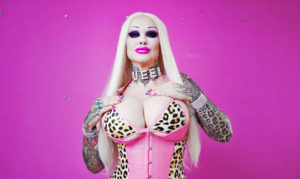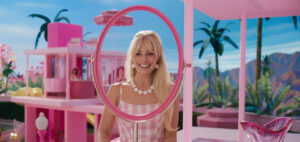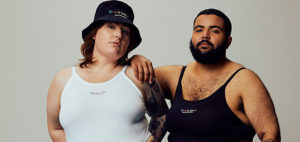A group of little girls sit in a circle and play a game called “Honestly”. It’s a sort of crowdsourced truth-or-dare, except it’s only “truth”, and there’s only one question: Am I beautiful?
The asker closes her eyes, and the girls in the circle raise a hand if they think the answer is yes. The raised hands are counted, then lowered; the asker opens her eyes and receives her rating, except it’s more like a life sentence, hot or not. She’ll never know who said she was beautiful, of course, but that’s not the point; the point is, how many people said so?
It’s a distinctly disempowering idea, that beautiful is something you cannot be until someone else bestows the word upon you. It’s also a recurring theme in the new horror novel in which this scene is set: Rouge, by Mona Awad. Exploring the terrible, pallid, preternaturally smooth underbelly of contemporary beauty culture, Rouge tells the story of a 30-something, skincare-obsessed woman named Belle, whose famously gorgeous mother has died suddenly and in deep debt to a mysterious seaside spa named La Maison de la Méduse.
In the novel’s third act, the protagonist gathers in a room with other women who are all nearing the end of what the spa’s proprietors refer to as their Beauty Journey. The room has no mirrors, and so the women have no choice but to ask each other how they look — but they’re also all suffering from memory loss, a known side effect of the spa’s coveted treatments, and struggling through brain fog. It’s hard to find the words, any words, to describe the beauty, the brightness, the glow. It’s like that game of “Honestly”, except worse: imagine having made unspeakable sacrifices to be, if not the fairest of them all, then certainly the fairest you ever have been or will be — and still, still, you cannot be sure of your beauty unless someone else confirms it.
This is also, of course, the paradox of beauty, especially in a post-feminist world. We’re supposed to be evolved enough that we simply don’t care whether or not other people think we’re beautiful — which has not in fact stopped us from caring, but has given rise to all kinds of intellectual acrobatics whereby we explain that the things we do to make ourselves prettier are actually a form of empowered self-indulgence. It’s the “I do it for me” trope (or, in parody form, “just for myself”), in which pandering to the gaze of some scrutinising — or sometimes lustful — other is presented as Extremely Feminist, Actually. The pervasive notion that all those creams and serums and peels and mists are actually a form of self-care is “I do it for me” in action, but it’s also among its least believable iterations. I mean, there it is, right in the name of the industry: “beauty”, that thing that is so famously in the eye of the beholder — who, it is understood, is not you. That would be just too vain.
One gets the sense that Awad has thought a lot about this paradox, what it means, and whether there’s a way around it. Belle is the rarest of beauty aficionados, a true believer who by all appearances actually is “doing it for me”. She is so isolated, so closed off, that she’s the only one around to do it for — and her skincare obsession only further distances her from the world. It is less about being seen than about concealing herself. Belle speaks of her regimen as if she’s putting on a suit of armour: it’s all shields and barriers and overcoats, a second and third and fourth skin on top of her skin. Awad plays expertly with the social aspects of beauty culture, the way that being pretty is a way of enticing people right up until you’re too pretty, and hence intimidating.
The weirdest thing about Belle is that the results of her skin regimen are, to her, irrelevant; an early scene finds her spackling herself in the dark, relishing the burn of the products on a face she can’t even see. But when she does start to care what her skin looks like — a shift in mindset that coincides with her first visit to La Maison de la Méduse — she claims the role of both beholder and beholden, consulting mirrors for answers much like a certain fairytale queen.
As for what other people think, it is more of an afterthought. The envy of other women is nice to have, but the male gaze is always intrusive, ridiculous or vaguely threatening — never desired. It is a strange and self-contradictory idea, that a person could want to look beautiful but also want nobody to look at her, but it does in fact embody what the “I do it for me” beauty ethos would look like if someone actually lived by it — which is to say, deeply weird and incredibly vain.
But then, Belle is a fictional character. In real life, it’s not so easy to draw a bright line between ordinary pride and toxic vanity, or between self-care and self-adornment — or, for that matter, basic human hygiene. We all do some sort of work to look presentable, even if it’s just bathing regularly. But is it beauty culture to wash your face? What if you’re washing it three times a day with 17 different products? Does it matter what the products are?
It all puts me in mind of the intensive beauty routine, if you want to call it that, that I was forced to adopt after I unknowingly pulled out a clutch of poison ivy in my back garden before making the terrible mistake of touching my face. The resulting rash required two dermatologist appointments and the regular application of three prescription creams, and in the weeks it took to resolve, I was more preoccupied with the state of my skin than I have ever been in my life before or since. Is that vanity? Maybe. I was much more perturbed by the threat of scarring than the itching, all told. But wouldn’t you be?
The truth is that what we call self-care is often more like self-preservation — not as in survival, but as in, well-preserved. What puts wrinkles on our faces? Frowning. Smiling. Feeling. Living. Real-life interventions such as Botox aim to prevent wrinkles by limiting facial movements. Awad goes further: in Rouge, the signature treatment at La Maison de Méduse deletes lines from a person’s face by deleting experiences, often traumatic, from her memory. It’s self-care as self-erasure; it’s The Eternal Sunshine of the Spotless Epidermis. It asks: might we be better off forgetting the things that keep us up at night, that hurt our feelings, and weather our skin? It seems the price of beauty is the loss of the ability to express yourself, one way or another.
It is this biting, satirical element in Rouge that feels most relevant to our present moment, when interrogating the moral valences of one’s beauty routine is increasingly as time-consuming and necessary as the routine itself. Sometimes it seems like a minor revolution is afoot, as beauty writers such as Jessica DeFino make careers not out of recommending products but dissecting our desire to use them, which is part of what DeFino calls “the money and soul-sucking cycle of beauty consumerism”. This beauty backlash can admittedly get a bit overwrought; but DeFino writes incisively about the inherent absurdity of the “I do it for me” ethos — in which beauty, like Sartre’s hell, is other people: “Beauty is a form of communication; by definition, an offering to or exchange with something or someone outside of ourselves.”
Why, then, does the “I do it for me” line persist? Maybe it’s the shame associated with wanting to be beautiful: to admit this is to admit that you have succumbed to the pressures of patriarchy. Surely a truly empowered woman would stride barefaced through the world, zits and wrinkles and moustache and all. (As is so often the case, this apotheosis of female empowerment and autonomy would be just an average weekday for a man.) But I’m not entirely persuaded by this.
If beauty is an offering, the coin of the realm, then beauty standards are the market index that tells us what’s valuable and what isn’t — and a woman’s looks, which is to say youth, which is to say skin, are an asset in this world whether she likes it or not. To maintain that asset in the form of skincare may be inherently other-focused, but isn’t the ultimate beneficiary the owner of said asset herself? Consider the statistic that conventionally attractive people earn up to 15% more than those less aesthetically blessed. In this context, what’s a few hundred or thousand bucks per year on treatments that help you stay prettier for longer, if not a savvy investment? If there were no advantages to being beautiful apart from the occasional appreciative glance, the knowledge that you inspire envy in those more wrinkled than yourself, surely we wouldn’t be anywhere near as obsessed with it?
Perhaps the question, then, is not whether we should spend anything — time, effort, money — on making ourselves look better, but on how much is too much. And who decides? Despite the alleged influence of patriarchy, this industry is ultimately fuelled by individual women making individual choices: the wellness mogul selling a $500 jade face roller, the beauty editor scoffing at it (what a scam, when you can buy a perfectly good face roller using one of our affiliate links for a mere $300!), or the eager consumer without whom there would be no market for jade face rollers in the first place.
Awad answers this question of how much is too much by going to extremes: if your pursuit of beauty costs your life savings, or your life itself, then yes, you’ve overpaid. Outside the realm of fiction, however, the answer is just another question: what is it worth to you when you close your eyes and ask, “Am I beautiful?”, to be certain that everyone is raising their hand?
Disclaimer
Some of the posts we share are controversial and we do not necessarily agree with them in the whole extend. Sometimes we agree with the content or part of it but we do not agree with the narration or language. Nevertheless we find them somehow interesting, valuable and/or informative or we share them, because we strongly believe in freedom of speech, free press and journalism. We strongly encourage you to have a critical approach to all the content, do your own research and analysis to build your own opinion.
We would be glad to have your feedback.
Source: UnHerd Read the original article here: https://unherd.com/





